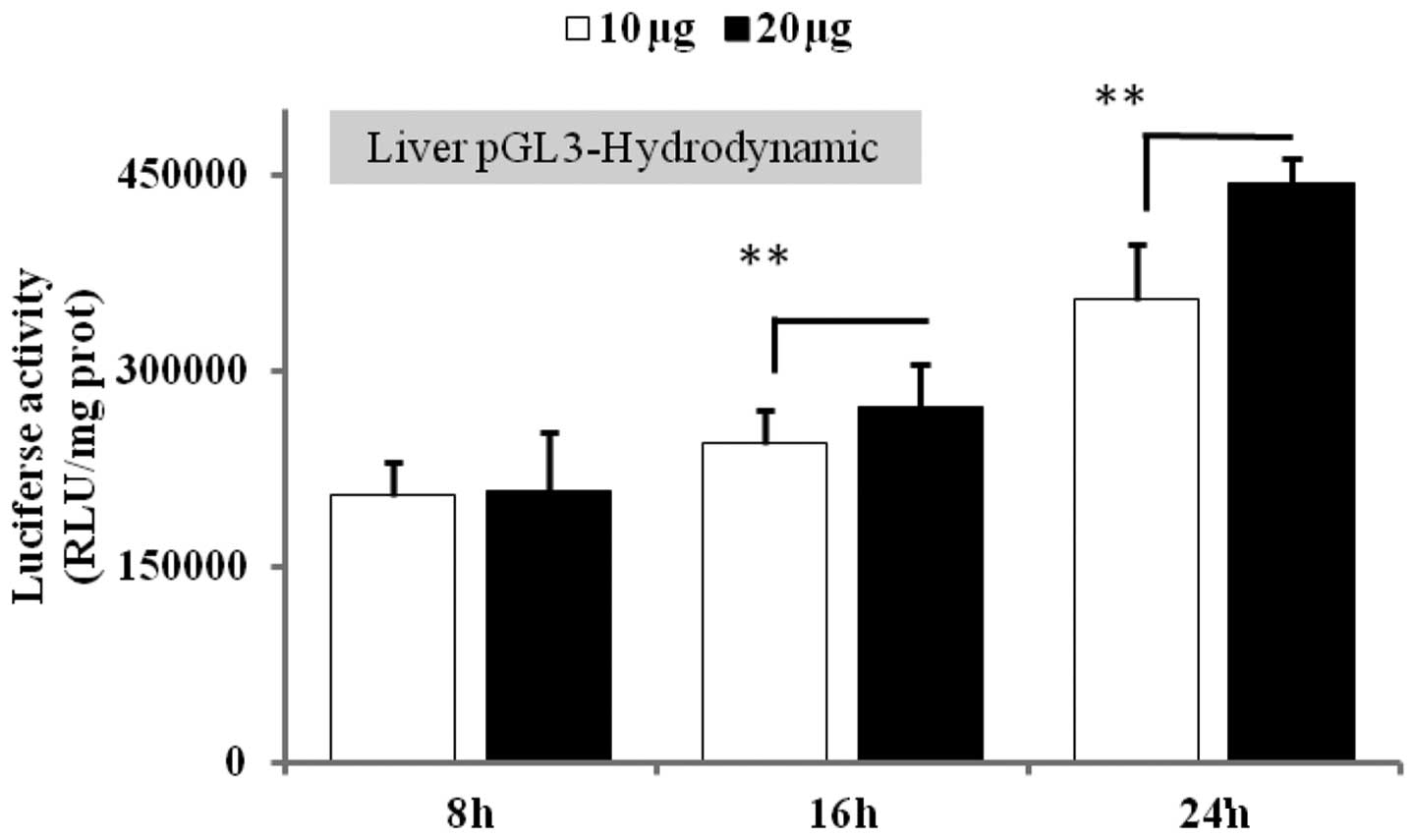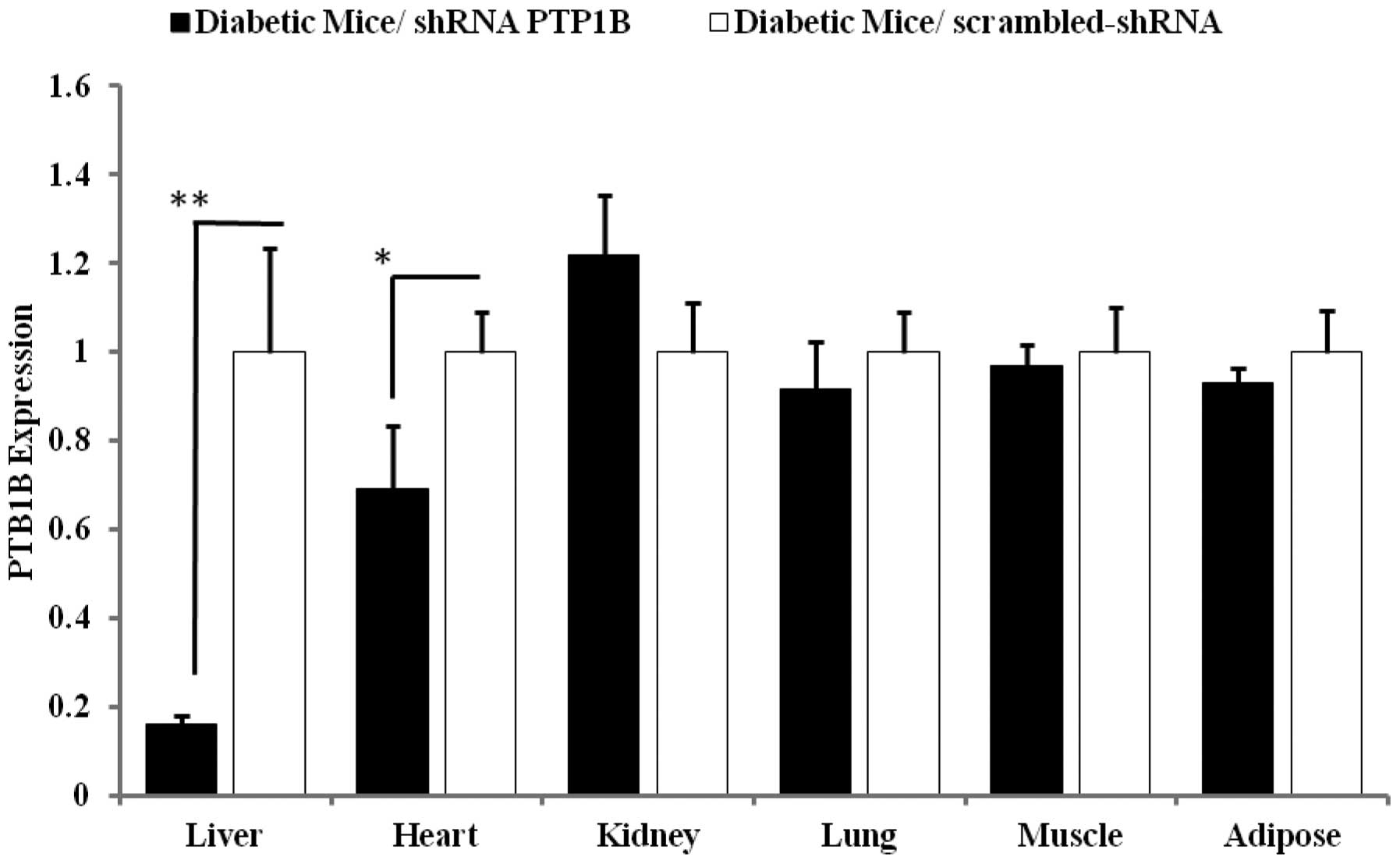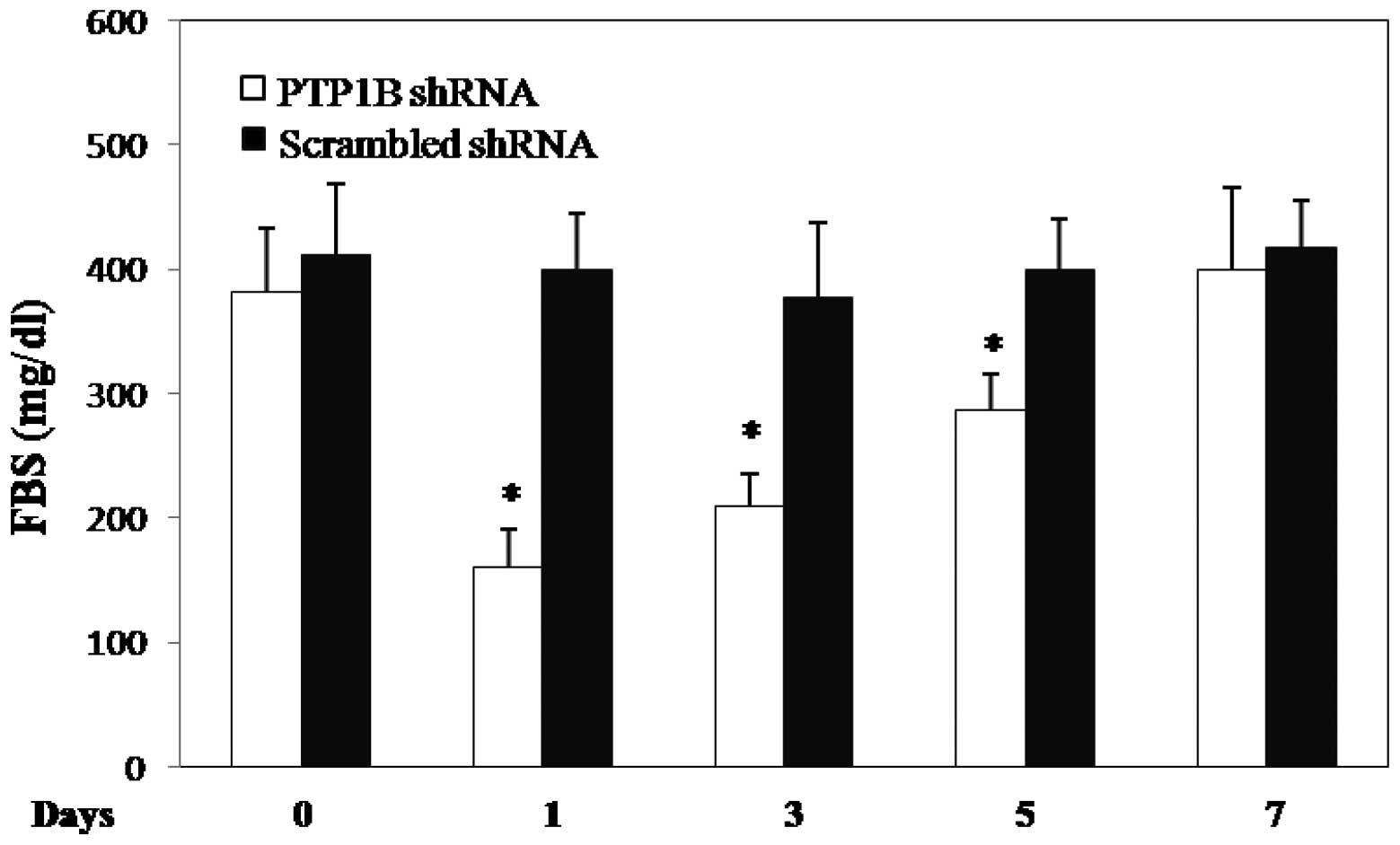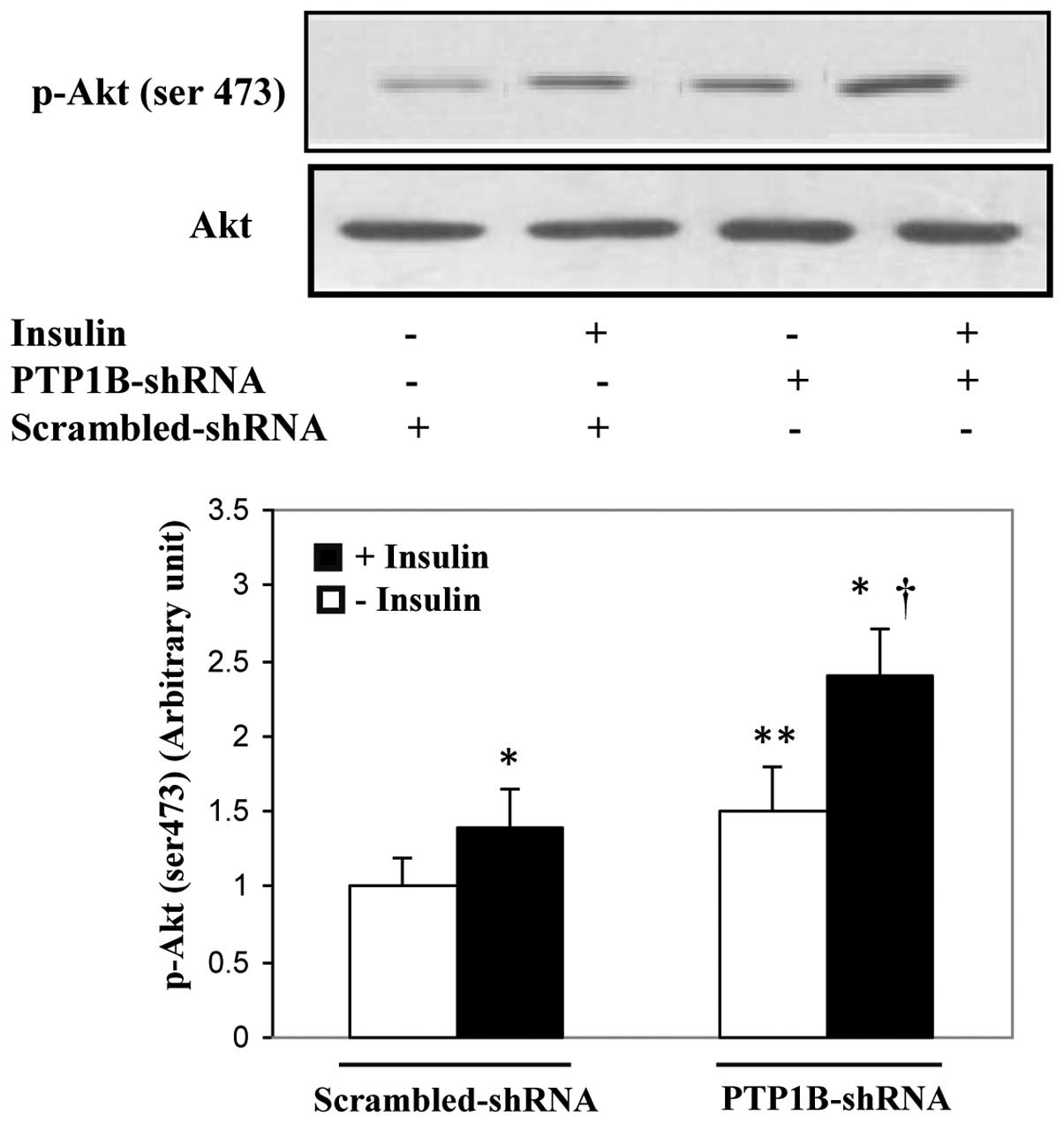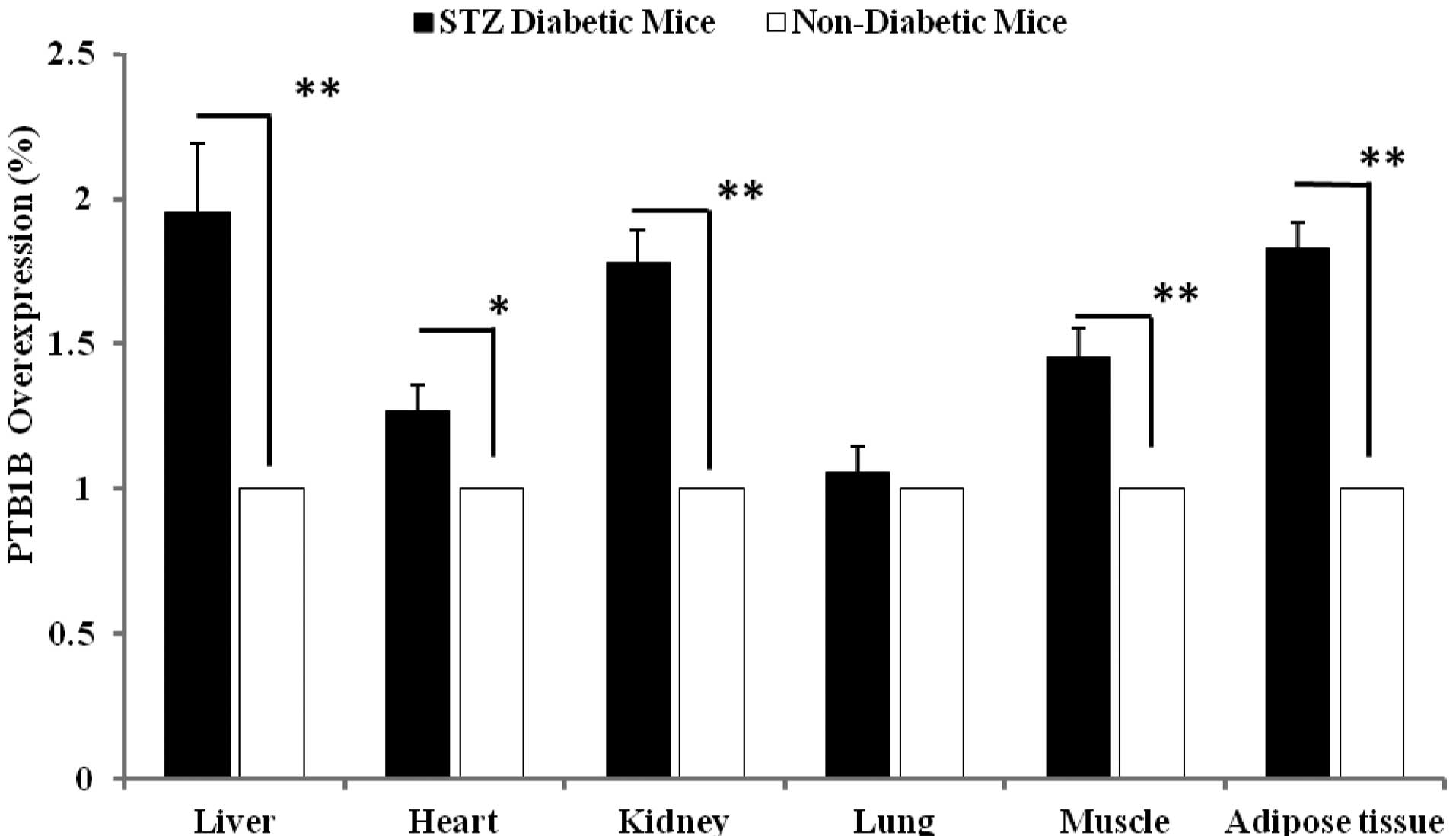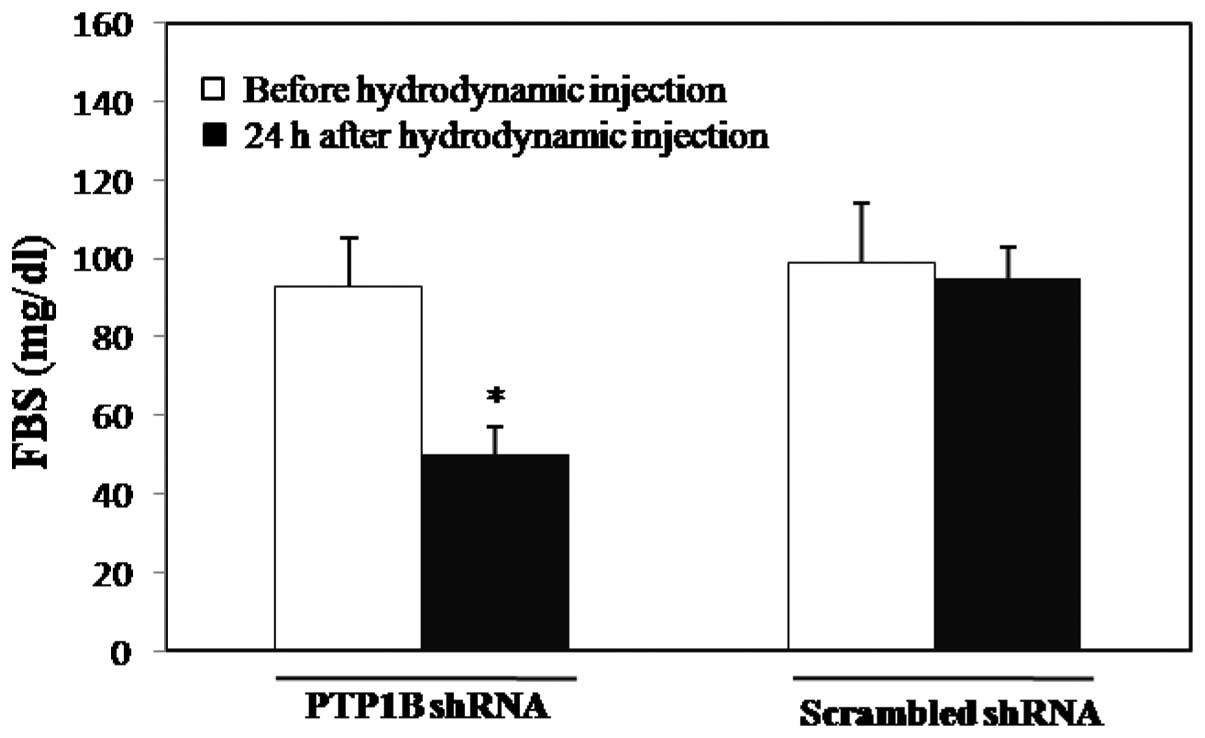|
1
|
Goldstein BJ: Regulation of insulin
receptor signaling by protein-tyrosine dephosphorylation. Receptor.
3:1–15. 1993.PubMed/NCBI
|
|
2
|
Zabolotny JM, Haj FG, Kim YB, Kim HJ, et
al: Transgenic overexpression of protein-tyrosine phosphatase 1B in
muscle causes insulin resistance, but overexpression with leukocyte
antigen-related phosphatase does not additively impair insulin
action. J Biol Chem. 279:24844–24851. 2004. View Article : Google Scholar
|
|
3
|
Elchebly M, Payette P, Michaliszyn E, et
al: Increased insulin sensitivity and obesity resistance in mice
lacking the protein tyrosine phosphatase-1B gene. Science.
283:1544–1548. 1999. View Article : Google Scholar : PubMed/NCBI
|
|
4
|
Klaman LD, Boss O, Peroni OD, et al:
Increased energy expenditure, decreased adiposity, and
tissue-specific insulin sensitivity in protein-tyrosine phosphatase
1B-deficient mice. Mol Cell Biol. 20:5479–5489. 2000. View Article : Google Scholar : PubMed/NCBI
|
|
5
|
Nieto-Vazquez I, Fernández-Veledo S, de
Alvaro C, Rondinone CM, Valverde AM and Lorenzo M: Protein-tyrosine
phosphatase 1B-deficient myocytes show increased insulin
sensitivity and protection against tumor necrosis
factor-alpha-induced insulin resistance. Diabetes. 56:404–413.
2007. View Article : Google Scholar
|
|
6
|
Dadke SS, Li HC, Kusari AB, Begum N and
Kusari J: Elevated expression and activity of protein-tyrosine
phosphatase 1B in skeletal muscle of insulin-resistant type II
diabetic Goto-Kakizaki rats. Biochem Biophys Res Commun.
274:583–589. 2000. View Article : Google Scholar : PubMed/NCBI
|
|
7
|
Ahmad F, Azevedo JL, Cortright R, Dohm GL
and Goldstein BJ: Alterations in skeletal muscle protein-tyrosine
phosphatase activity and expression in insulin-resistant human
obesity and diabetes. J Clin Invest. 100:449–458. 1997. View Article : Google Scholar : PubMed/NCBI
|
|
8
|
Wu Y, Ouyang JP, Wu K, Wang SS, Wen CY and
Xia ZY: Rosiglitazone ameliorates abnormal expression and activity
of protein tyrosine phosphatase 1B in the skeletal muscle of
fat-fed, streptozotocin-treated diabetic rats. Br J Pharmacol.
146:234–243. 2005. View Article : Google Scholar : PubMed/NCBI
|
|
9
|
Adeli K, Macri J, Mohammadi A, Kito M,
Urade R and Cavallo D: Apolipoprotein B is intracellularly
associated with an ER-60 protease homologue in HepG2 cells. J Biol
Chem. 272:22489–22494. 1997. View Article : Google Scholar : PubMed/NCBI
|
|
10
|
Zabolotny JM, Kim YB, Welsh LA, Kershaw
EE, Neel BG and Kahn BB: Protein-tyrosine phosphatase 1B expression
is induced by inflammation in vivo. J Biol Chem. 283:14230–14241.
2008. View Article : Google Scholar : PubMed/NCBI
|
|
11
|
Parvaneh L, Meshkani R, Bakhtiyari S, et
al: Palmitate and inflammatory state additively induce the
expression of PTP1B in muscle cells. Biochem Biophys Res Commun.
396:467–71. 2010. View Article : Google Scholar : PubMed/NCBI
|
|
12
|
MohammadTaghvaei N, Meshkani R, Taghikhani
M, Larijani B and Adeli K: Palmitate enhances protein tyrosine
phosphatase 1B (PTP1B) gene expression at transcriptional level in
C2C12 skeletal muscle cells. Inflammation. 34:43–48. 2011.
View Article : Google Scholar : PubMed/NCBI
|
|
13
|
Wu J, Yang LJ and Zou DJ: Rosiglitazone
attenuates tumor necrosis factor-α-induced protein-tyrosine
phosphatase-1B production in HepG2 cells. J Endocrinol Invest.
35:28–34. 2012.
|
|
14
|
Haj FG, Zabolotny JM, Kim YB, Kahn BB and
Neel BG: Liver-specific protein-tyrosine phosphatase 1B (PTP1B)
re-expression alters glucose homeostasis of PTP1B−/−
mice. J Biol Chem. 280:15038–15046. 2005. View Article : Google Scholar : PubMed/NCBI
|
|
15
|
Delibegovic M, Bence KK, Mody N, et al:
Improved glucose homeostasis in mice with muscle-specific deletion
of protein-tyrosine phosphatase 1B. Mol Cell Biol. 27:7727–7734.
2007. View Article : Google Scholar : PubMed/NCBI
|
|
16
|
Gu P, Jiang W, Du H, Shao J, Lu B, Wang J
and Zou D: Protein tyrosine phosphatase 1B gene polymorphisms and
essential hypertension: a case-control study in Chinese population.
J Endocrinol Invest. 33:483–488. 2010. View Article : Google Scholar : PubMed/NCBI
|
|
17
|
Meshkani R, Taghikhani M, Al-Kateb H,
Larijani B, et al: Polymorphisms within the protein tyrosine
phosphatase 1B (PTPN1) gene promoter: functional characterization
and association with type 2 diabetes and related metabolic traits.
Clin Chem. 53:1585–1592. 2007. View Article : Google Scholar
|
|
18
|
Meshkani R, Taghikhani M, Mosapour A, et
al: 1484insG polymorphism of the PTPN1 gene is associated with
insulin resistance in an Iranian population. Arch Med Res.
38:556–562. 2007. View Article : Google Scholar : PubMed/NCBI
|
|
19
|
Delibegovic M, Zimmer D, Kauffman C, et
al: Liver-specific deletion of protein-tyrosine phosphatase 1B
(PTP1B) improves metabolic syndrome and attenuates diet-induced
endoplasmic reticulum stress. Diabetes. 58:590–599. 2009.
View Article : Google Scholar
|
|
20
|
Swarbrick MM, Havel PJ, Levin AA, et al:
Inhibition of protein tyrosine phosphatase-1B with antisense
oligonucleotides improves insulin sensitivity and increases
adiponectin concentrations in monkeys. Endocrinology.
150:1670–1679. 2009. View Article : Google Scholar
|
|
21
|
Koren S and Fantus IG: Inhibition of the
protein tyrosine phosphatase PTP1B: potential therapy for obesity,
insulin resistance and type-2 diabetes mellitus. Best Pract Res
Clin Endocrinol Metab. 21:621–40. 2007. View Article : Google Scholar : PubMed/NCBI
|
|
22
|
Zhang S and Zhang ZY: PTP1B as a drug
target: recent developments in PTP1B inhibitor discovery. Drug
Discov Today. 12:373–381. 2007. View Article : Google Scholar : PubMed/NCBI
|
|
23
|
Xu J, Li L, Hong J and Huang W: Effects of
small interference RNA against PTP1B and TCPTP on insulin signaling
pathway in mouse liver: evidence for non-synergetic cooperation.
Cell Biol Int. 31:88–91. 2007. View Article : Google Scholar : PubMed/NCBI
|
|
24
|
Bakhtiyari S, Meshkani R, Taghikhani M,
Larijani B and Adeli K: Protein tyrosine phosphatase-1B (PTP-1B)
knockdown improves palmitate-induced insulin resistance in C2C12
skeletal muscle cells. Lipids. 45:237–244. 2010. View Article : Google Scholar : PubMed/NCBI
|
|
25
|
Maruyama H, Higuchi N, Nishikawa Y, et al:
High level expression of naked DNA delivered to rat liver via tail
vein injection. J Gene Med. 4:333–341. 2002. View Article : Google Scholar : PubMed/NCBI
|
|
26
|
Meshkani R and Adeli K: Hepatic insulin
resistance, metabolic syndrome and cardiovascular disease. Clin
Biochem. 42:1331–1346. 2009. View Article : Google Scholar : PubMed/NCBI
|
|
27
|
Liu F, Song YK and Liu D:
Hydrodynamics-based transfection in animals by systemic
administration of plasmid DNA. Gene Ther. 6:1258–1266. 1999.
View Article : Google Scholar : PubMed/NCBI
|
|
28
|
McAnuff MA, Rettig GR and Rice KG: Potency
of siRNA versus shRNA mediated knockdown in vivo. J Pharm Sci.
96:2922–2930. 2007. View Article : Google Scholar
|
|
29
|
Ventura-Sobrevilla J, Boone-Villa VD,
Aguilar CN, et al: Effect of varying dose and administration of
streptozotocin on blood sugar in male CD1 mice. Proc West Pharmacol
Soc. 54:5–9. 2011.PubMed/NCBI
|
|
30
|
Lewis DL and Wolff JA: Systemic siRNA
delivery via hydrodynamic intravascular injection. Adv Drug Deliv
Rev. 59:115–123. 2007. View Article : Google Scholar : PubMed/NCBI
|
|
31
|
Galic S, Hauser C, Kahn BB, et al:
Coordinated regulation of insulin signaling by the protein tyrosine
phosphatases PTP1B and TCPTP. Mol Cell Biol. 25:819–829. 2005.
View Article : Google Scholar : PubMed/NCBI
|















